|
The user interface for the Kast motor controller is started from user
account on gouda, shanevnc, or karnak by typing
kast start obs. You will be presented with a GUI as shown
Figure 1. The controller will display the current spectrograph motor
positions, and will allow you either to change the individual
parameters, or to reconfigure using stored setups. The GUI
communicates with the hardware via the dispatcher software. While
these dispatchers should always be running, there is a chance you will
have to start them as well. You can start the dispatchers by typing
kast start disp (and you may determine the status of the
dispatcher software with the command kast status). There is no
harm in trying to start the dispatchers if they are already running.
The Kast controller GUI may be stopped either from the File-Quit
menu item or by typing kast stop obs. While there should be no
need to ever stop the kast dispatchers, they may be stopped with the
command kast stop disp.
The spectrograph controller operates two separate galil motor controllers
which work in parallel. Multiple stages on each controller may move at the
same time. This means that if you want to change a number of items, you
should not wait until one is done before requesting the next change.
Make as many changes as you wish as quickly as you wish, and the
controller will get it all done as soon as possible. The display will
inform you what the status is of each item via the icons to the right
of each stage's section of the GUI.
The motors are divided into three categories based on where in the
light path they are: Blue side (left section with blue backgroud),
Common path (middle section with grey background), and Red side (right
section with red background).
Each motor has its own control interface within the GUI and each works
in a similar way. For motors with defined positions (e.g. Decker),
click on the name of the position (e.g. Finger) and it will give you a
menu of available positions. Simply click on the desired position and
it will be shown with a yellow background and a green arrow will
appear immediately to the right (Figure 2). The yellow background is a
warning that the motor has not yet moved. To move the motor click on
the green arrow.
The Collimators and Grating Tilt stages, do not have predefined
positions. Enter your desired position into the entry box or use the
up and down arrows to the left of the entry box to change the value
(the default collimator step for the arrows is 3.0 mm and 1000 encoder
counts for the grating tilt stage). The Slit and Waveplate stages
have predefined positions but also have an Other... option (Figure
3) where you can enter your desired value (slit widths must be between
0.4 and 150 arcsec, waveplate rotation must be between 0 and 360
degrees). As for the predefined positions, the background will change
to yellow and a green arrow will appear to the right of the entry
box. Click the green arrow to move the motor.
Status of the motors and instrument is shown with the icons to the
right of each motor name. The red/blue arrows indicate the direction
of the light path. If Kast is configured so that light is blocked by
an optical element, then a bar will appear at the head of the arrow to
indicate the issue (and arrows down stream of that blockage will
vanish from the GUI) (Figure 5). A green circle with white check
(Figure 4) indicates that the motor is ready and may be moved. A
yellow triangle icon indicates a warning and that the motor has a
minor issue. A red circle with white X (Figure 5) indicates that the
motor is in an error state and should not (or can not) be moved. To
get more information on the source of the warning or error, click on
the icon and a detail panel (Figure 6) will appear. When a motor is
moving you may get one of two icons (depending on the motor and its
state). During normal operations when a motor is moving a black and
green pie chart will appear showing its progress (Figure 4). During
calibration of the motor an grey gear icon will show that the motor is
moving (Figure 5). If software control of a motor is disabled (locked
out) for safety, a padlock icon (Figure 4) will be displayed. Do not
unlock a stage unless you are 100% sure that it is safe to do so.
|
 |
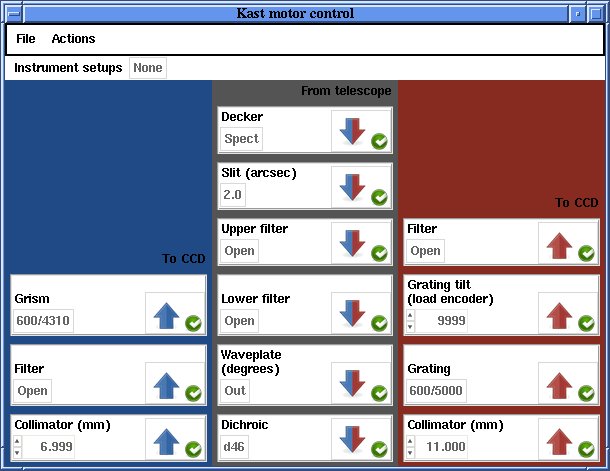
Figure 1: Kast Controller User Interface

Figure 2: Selection and Go Arrow
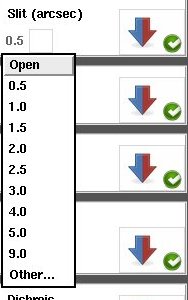
Figure 3: Slit width menu


Figure 4: Motor Moving and Lock icons


Figure 5: Motor Warning and Error icons
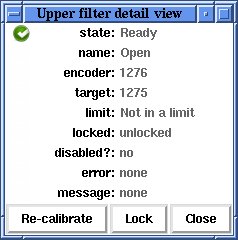
Figure 6: Detail Panel
|
|
The menu bars have three options: File,
Actions, and Instrument setups. Keyboard shortcuts are also listed in the menus where
they are available.
The File menu (Figure 7) lets you increase or decrease the font size
as well as Quit the GUI.
The Actions menu (Figure 8) has the following options:
- Cancel pending (Ctrl+c) -- Clear any desired positions from the GUI
that don't match the actual positions of the motors.
- Apply pending (Ctrl+m) -- Move all motors whose desired positions don't match
the actual positions.
- Enable motion -- Place all motorized stages in the proper state for regular operation, which
includes calibrating stages as needed. Observers should not generally need this option.
- Calibrate -- This menu has two options, either to calibrate All stages or just
the Uncalibrated stages. Individual motors can be re-calibrated from the Detail Panel (Figure 6).
Calibrating all stages can take a while, so should only be done as needed (e.g. when the motor controller
is first turned on after mounting on the telescope). Please make sure no one is working on the instrument
before re-calibrating all the motors, as injuries could occur.
- Stop all motion -- Stops the motion of all motors. Generally should not be needed,
but good option in case of emergency (power glitches, runaway stages, etc.).
- Lock stages... -- Lock out software control of
selected stages for safety while staff members work on hardware or
prevent motion of misbehaving motors. This brings up the Lock GUI
(Figure 9) where you can select which stages to lock out (the default
is to lock out all stages). You must supply a reason for the
lockout. The lockout icon is shown in Figure 4.
- Unlock all -- Unlocks the software control of all locked
out stages. For safety reasons do not unlock a stage unless
you have consulted with the person(s) working on the hardware.
The Instrument setups menu (Figure 10) allows you to Load or Save motor
setups, as well as Choose a directory for setups.
The Load... option will bring up a file browser dialog
where you select your saved setup. It will load in the data and you
may either move all motors to the desire positions using Actions -
Move all or move the motors using the green arrows in each motor
section.
The Save new setup... option allows you to save the currently
displayed positions to a file for future use. You do not have to move
the motor to the desired position to save it in a setup, it must
simply be selected and displayed in the GUI. Once the desired motor
positions are displayed, click on Instrument setups - Save new
setup... and the Save Setup GUI will appear (Figure 11). By
default all motors will be selected (yellow background) to be saved in
the setup. You may unselect a stage by clicking on it (it will then
have a white background). You may unselect all stages by clicking
Unselect all. Once you have selected your desired stages,
click Save As... to bring up a file browser dialog to name and
save your file. Please save your setup to your subdirectory
/u/user/observers/. Files saved elsewhere may be deleted or modified
without notice.
If you have existing setup files in your /u/user/observers/ subdirectory, you may
select that directory using the Choose directory... option. When you click on Instrument
setup you will have a list of existing setups to choose from (e.g. Figure 12). If the motor
positions match an existing setup it will show that setup's name in the Instrument setup menu
bar and highlight it in yellow in the setup selection list. You add the option
to Clear setup list.
|
 |
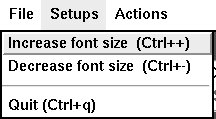
Figure 7: File Menu
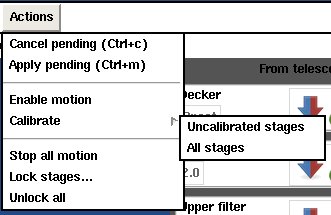
Figure 8: Actions Menu
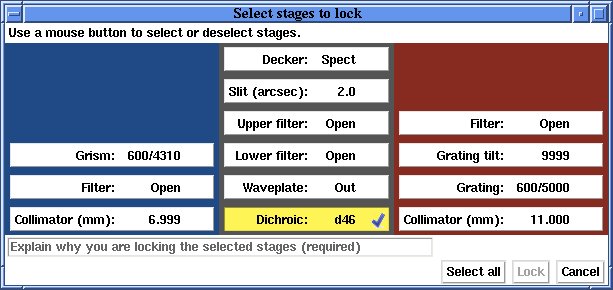
Figure 9: Lock GUI
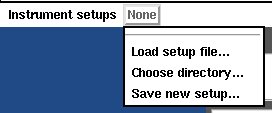
Figure 10: Setups Menu
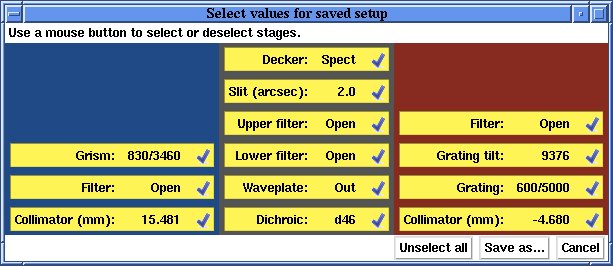
Figure 11: Save Setup GUI
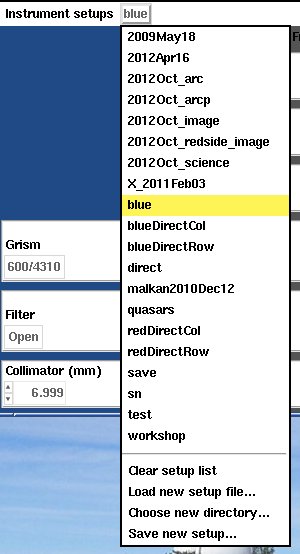
Figure 12: Setup Selection Menu
|